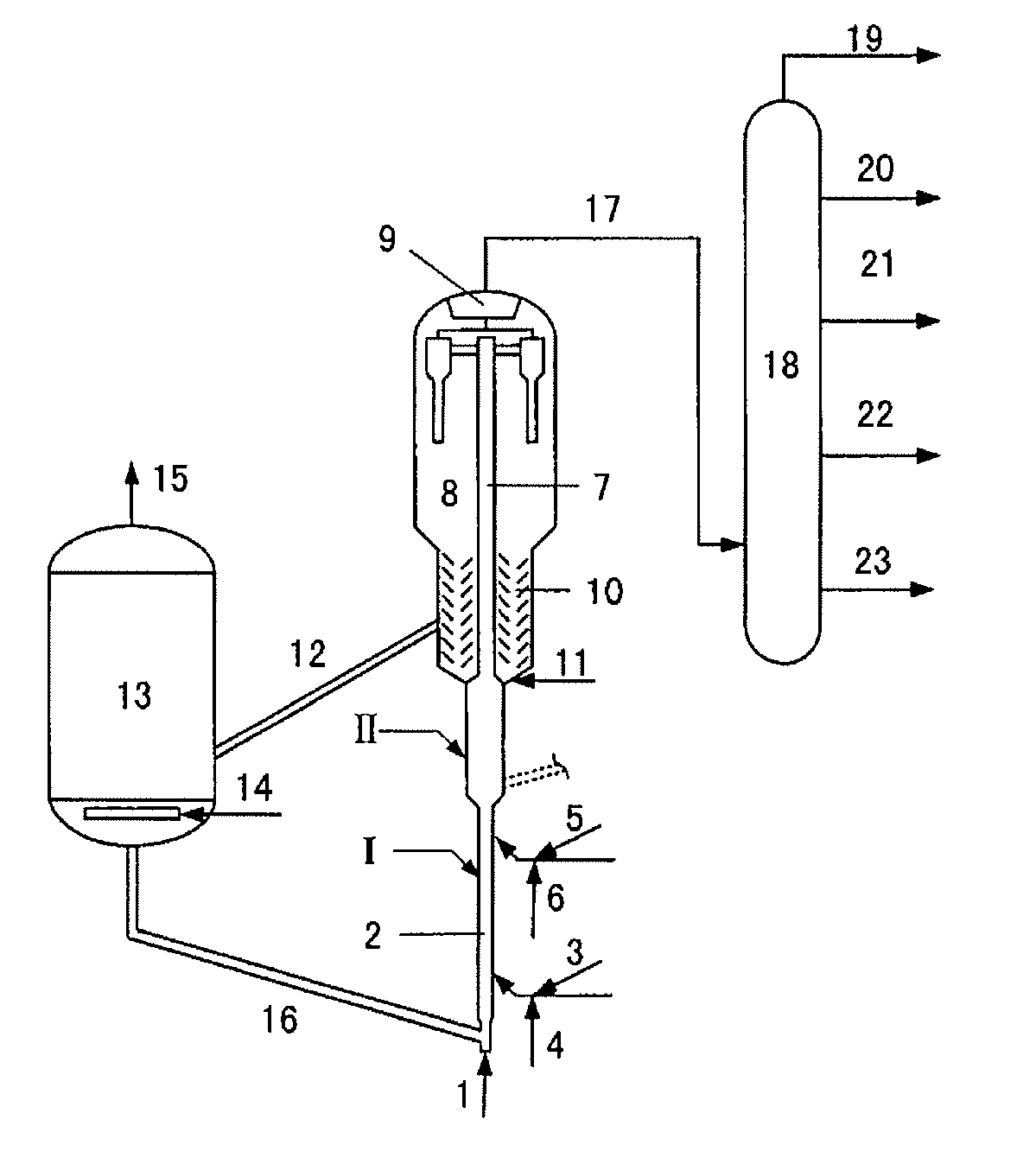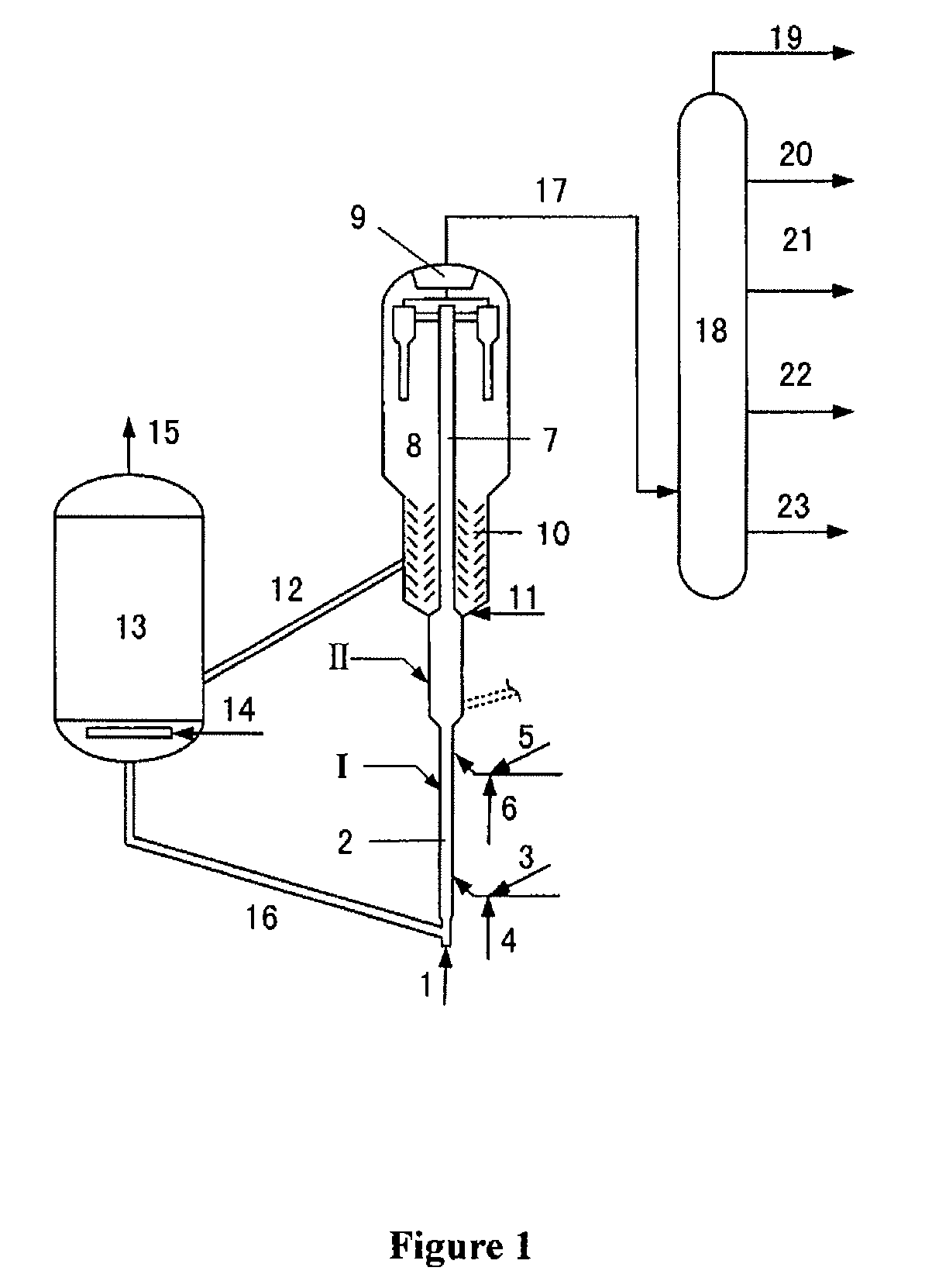Catalytic conversion process
a conversion process and catalytic technology, applied in the field of catalytic conversion process, can solve the problems of high cost, deficiency of processing capacity, and shortage of light feedstock in the petrochemical industry, and achieve the effects of reducing the yield of dry gas and coke, enhancing the yield of propylene, and maximizing the utilization of petroleum oil resources
- Summary
- Abstract
- Description
- Claims
- Application Information
AI Technical Summary
Benefits of technology
Problems solved by technology
Method used
Image
Examples
example 1
[0083]The experiment of the present example was carried out according to the scheme shown in FIG. 1. Feedstock A was directly used as the feedstock of catalytic cracking and the experiment was conducted in a pilot riser reactor plant. Feedstock A was injected into the reaction zone I, wherein the catalytic cracking reaction was conducted. The reaction temperature was 530° C., the WHSV was 30 h−1, the C / O was 10, and the weight ratio of steam / the feedstock was 0.15. Reaction product vapors and the coked spent catalyst were separated in the disengager, and then the products were separated, wherein propylene, the gasoline and the FGO were withdrawn. Operating conditions and product slate were listed in table 2.
[0084]It can be seen from Table 2 that the yield of propylene attains as high as 18.29% by weight and those of dry gas and coke are only 2.36% and 3.95% by weight respectively, and the FGO yield is 30.12% by weight whose hydrogen content is 11.08% by weight.
example 2
[0085]The experiment of the present example was carried out according to the scheme shown in FIG. 2. Feedstock A was directly used as the feedstock of catalytic cracking and the experiment was conducted in a pilot riser reactor plant. Easy crackability feedstock was injected into the middle-upper portion of reaction zone I, wherein the reaction temperature was 580° C., the WHSV was 60 h−1, the catalytic cracking catalyst / the easy crackability feedstock (m / m) was 10, the weight ratio of steam / the easy crackability feedstock was 0.15. Hard crackability feedstock was charged in the bottom of the reaction zone I, wherein the reaction temperature was 640° C., the WHSV was 180 h−1, the catalytic cracking catalyst / the hard crackability feedstock (m / m) was 60, and the weight ratio of steam / the hard crackability feedstock was 0.20. In reaction zone II, the reaction temperature was 540° C., the WHSV was 30 h−1, and the weight ratio of steam / the easy crackability feedstock was 0.15. Reaction p...
example 3
[0087]The experiment of the present example was carried out in the same plant as that in Example 2. Feedstock B was directly used as the feedstock of catalytic cracking and the experiment was conducted in a pilot riser reactor plant. Easy crackability feedstock was injected into the middle-upper portion of reaction zone I, wherein the reaction temperature was 580° C., the WHSV was 60 h−1, the catalytic cracking catalyst / the easy crackability feedstock (m / m) was 10, and the weight ratio of steam / the easy crackability feedstock was 0.15. Hard crackability feedstock was charged in the bottom of the reaction zone I, wherein the reaction temperature was 640° C., the WHSV was 180 h−1, the catalytic cracking catalyst / the hard crackability feedstock (m / m) was 60, and the weight ratio of steam / the hard crackability feedstock was 0.20. In addition, a portion of the stripped spent catalyst was introduced from the stripping section into the bottom of the reaction zone II, so as to decrease the ...
PUM
| Property | Measurement | Unit |
|---|---|---|
| boiling point | aaaaa | aaaaa |
| boiling point | aaaaa | aaaaa |
| boiling point | aaaaa | aaaaa |
Abstract
Description
Claims
Application Information
 Login to View More
Login to View More - R&D
- Intellectual Property
- Life Sciences
- Materials
- Tech Scout
- Unparalleled Data Quality
- Higher Quality Content
- 60% Fewer Hallucinations
Browse by: Latest US Patents, China's latest patents, Technical Efficacy Thesaurus, Application Domain, Technology Topic, Popular Technical Reports.
© 2025 PatSnap. All rights reserved.Legal|Privacy policy|Modern Slavery Act Transparency Statement|Sitemap|About US| Contact US: help@patsnap.com



